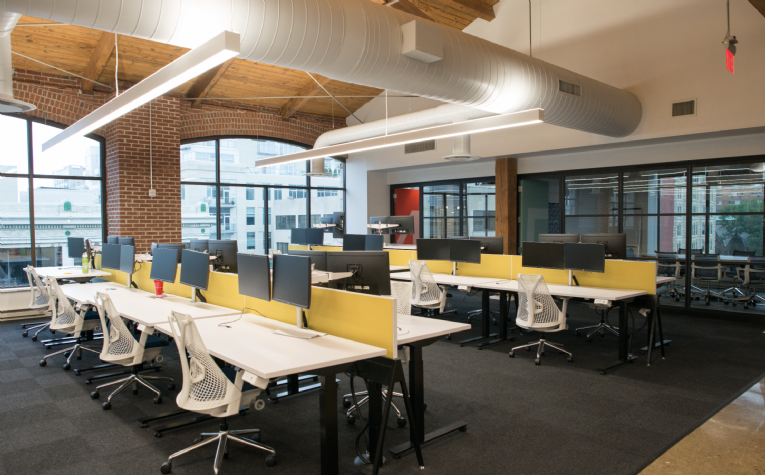Change Management for a Neuroinclusive Workplace
Your company has made the investment and the effort to become a neuroinclusive workplace — with the buy-in of leadership, the company has engaged in a strategic planning process and adopted neuroinclusive space or policy approaches in the work environment. Now what?
Organizational and workplace change affects all people, at various points. For this reason, it's necessary to have structured process to bridge the gap from an existing state to the desired future state. This is called change management. Managing the journey to a more neuroinclusive workplace is especially important if the concept of neurodiversity is new to a majority of employees. It may require a change in thinking, shifts in behavior, and an understanding of new space types or tools at work. Let’s take a closer look at some key guiding principles for this process.
Communication is Core to Change
Because of its broad impact, organizational change will always be more successful with the buy-in and participation of employees. Therefore, integrating employees into the process of change is ideal. The implementation of any change begins with leadership’s buy-in and continues with strong advocacy. From here, generating employees’ enthusiasm and support for change starts in the earliest planning stages and continues until the organization reaches its desired state.
The following principles and practices will drive a change management process that promotes participation and achieves change with broad buy-in:
Early exposure and buy-in
Ideally, before any company adopts space or policy changes, they will begin with a testing strategy such as a mock-up (for space) or a pilot (for space, policy, or technology). This allows employees to be involved in the process and exposes them to possible new workspaces or ways of working. It is leadership’s time to solicit feedback, while also giving employees ownership in the outcome and to spark some excitement for what is to come.
Communication plan
Communication is the core of any change management process. When the company has opted to implement new space, a new policy direction, and/or new tools, it is time to communicate these changes broadly and prepare employees for new ways of using space or working.
Your change management team can work closely with a corporate communications group, if applicable, to determine the timing and channels of communication. This may involve multiple mediums — for example, a series of all-staff meetings or lunch and learns accompanied by regular updates on a company intranet and an internal email campaign.
Any communication plan must be set up as a two-way system. All employees should be encouraged to ask questions or air concerns and be given the proper platforms to do it, whether it’s participating in a Q&A session at an all-staff meeting, submitting feedback anonymously online, or scheduling an in-person meeting with an HR representative.
Organizational change should never happen to anyone in the workplace. Rather, the goal is to implement a communications plan to encourage participation, foster understanding and ownership, and communicate roles and responsibilities. When employees have a clear picture of what is ahead and how it will benefit everyone, they are more likely to feel involved and offer support.
Education and training
The foundation of achieving a neuroinclusive workplace is cultural change. Sharing knowledge company-wide and training managers will spark the cultural shift. Ideally, education and training will begin during the strategic planning phase and continue through design and post-design as the change is communicated location- or company-wide.
Spreading awareness of neurodiversity can start with holding workshops or information sessions with consultants who specialize in the subject. From here, train managers in best practices for supporting employees who disclose neurodiverse conditions or needs at work. Managing a team with diverse needs and work styles requires flexibility and empathy.
General training should be offered to all employees, making the same information accessible to all, such as how to request special equipment, furniture, or technology, or how to request or access designated space types. For neurodivergent employees, supplementing widely available information with access to other support resources, such as a DEI or neurodiversity affinity groups, can help build a truly inclusive environment.
Success metrics
Implementing change without assessing the outcomes stifles growth and possibility. Remember to measure the return on your investment. Your change management team will work with you to establish KPIs at the beginning of the change management process. At a predetermined time after the conclusion of the process (for example, six months), it is useful to collect data to measure against the KPIs.
Whatever the outcome of this post-change evaluation, it will be important for companies to critically engage with the feedback they receive and make the necessary adjustments. Leaving workspace or policy changes in place that are not working can have a corrosive effect over time, in the form of employee attrition or disengagement.
While this would constitute the end of a project for a change management team, many companies may choose to adopt a regular cadence of review and adjustments. Doing so allows the company to remain proactive in assessing workplace effectiveness. Given the continuing rise in diagnoses of neurodiverse conditions, companies that are truly interested in maintaining a neuroinclusive culture will want to ensure they stay connected to how their workplace functions as new talent onboards and needs to evolve.
Committing to Change
In this series, we’ve examined how the corporate world will benefit from embracing neurodiversity, how to strategically plan the workplace to support neurodiverse talent, essential workplace design considerations and how to manage the change. It’s a marathon, not a sprint; but following a structured, incremental process — and leaving room to learn from mistakes — will yield results. For companies genuinely committed to fostering an inclusive culture and harnessing invaluable skills and talents, embarking on a neurodiversity initiative is a shrewd and powerful strategy.

-(3).png)
-(1)(1).png)

.png)
(7).jpg)
.png)

(2).jpg)
(1).jpg)
.jpg)
(6).jpg)
(5).jpg)